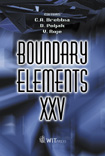Performance Evaluation Of Some New Time Integration Methods In Elastodynamic Problems Formulated By Dual Reciprocity Boundary Element Method
Price
Free (open access)
Transaction
Volume
35
Pages
10
Published
2003
Size
410.42 kb
Paper DOI
10.2495/BE030321
Copyright
WIT Press
Author(s)
G. A. Velazquez Castillo & C. F. Loeffler
Abstract
Performance evaluation of some new time integration methods in elastodynamic problems formulated by dual reciprocity boundary element method G. A. Velkquez Castillo & C. F. Loeffler Mechanical Engineering Department, Universidade Federal do Espirito Santo, Brazil Abstract This paper presents the results obtained with Dual Reciprocity Boundary Element Formulation applied to dynamic problems. In spite of the generally good performance, wave propagation problems demand still greater attention in controlling the higher modes, especially under impact loading. To improve the traction response, numerical simulations were done with three time integration methods with parametric control of dissipation: the well-known Wilson-8 scheme, the HHT-a method and the recently devised CHL-p method. 1 Introduction Dual Reciprocity (DR) is a technique of Boundary Element Method (BEM) initially idealized for the solution of free vibration problems [I]. DR allows obtaining the final matrix equations in a form simi
Keywords





